Unless you’ve been living under a rock, you’ve probably heard how organic reach on Facebook has been on the decline over the last few years, driving the need for brands to focus more on Facebook sponsored posts.
But what are Facebook sponsored posts? How do they work? And what is the difference between a Facebook sponsored post and Facebook ads? We’ve got the answers for you here.
What are Facebook sponsored posts?
A Facebook sponsored post is a post that businesses pay for, in order to reach a larger audience than they otherwise would be able to organically. Simply put, when you see the term "sponsored" on Facebook, it indicates that the post is from a business that has invested money to display their content to you, regardless of whether you currently follow that business or not.
A Facebook sponsored post is almost entirely like an ordinary post in appearance, as it looks just the same as all other posts inside a user’s feed (formerly known as “newsfeed”), the only difference is that a sponsored post is labelled as such.
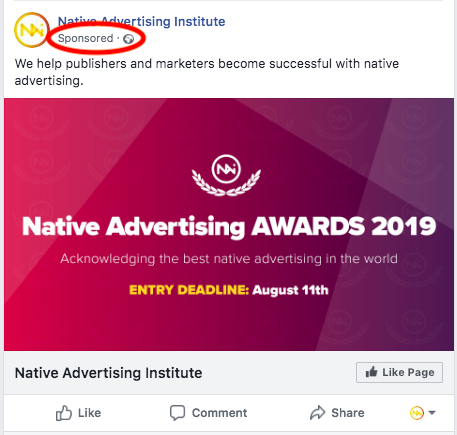
Sponsoring a post on Facebook is an easy and quick process and a great way to get more - and more relevant - eyes on a post. It’s important, though, that when you sponsor a post, you have a clear audience in mind and your messaging is appropriately targeted toward that audience, but we’ll talk more about this later.
First, let’s take a look at how Facebook Sponsored Posts work.
How do Facebook Sponsored Posts work?
A Facebook sponsored post is essentially a normal organic post that you pay to ‘boost’ in order to reach an audience outside of the people already following your business on Facebook.
Let's say you want to promote a conference to a group of new people. You may already have a Facebook business page related to your conference but you want to reach a wider audience, or perhaps an audience with a specific geographic location. Whatever your goals are, a Facebook sponsored post will allow you to reach more of the people who may be interested in the conference you are hosting.
Why should you sponsor a post on Facebook?
Why sponsor a Facebook post instead of just posting it and hoping for the best?
The answer is simple. In 99.9% of cases, your organic post on Facebook will likely reach very few new people, if any at all.
Organic reach on Facebook, was estimated to be somewhere around 2.2% as of 2021 (depending on different variables – such as the size of your following – some brands can experience as low as 1% organic reach). This means that when you simply post on your Facebook business site, people most likely won’t see it or interact with it despite how engaging or relevant the post might be.
We saw dwindling Facebook organic reach as early as 2014, and by 2017, it had dropped from 26% in 2011 to 0.5%. This was largely attributed to an increase in competition, as more and more businesses were taking to Facebook, crowding out feeds.
The dramatic drop-off we've seen over recent years, though, has been largely attributed to continuous changes in the Facebook algorithm. These changes are aimed at making users’ feeds more relevant to them.
As Facebook’s organic reach continues to decline for businesses, it becomes increasingly more important for brands and marketers to leverage paid content to boost the visibility of their Facebook business pages.
In other words, if you want to make sure that a greater number of your followers are able to see your content, you often have to pay to get a better reach.
A shift away from users being inundated with low-quality news stories or content is perhaps a welcomed change. But it does make it harder for brands to get their content seen. This is why it’s so critical for businesses and brands to sponsor their posts.
What’s more, a recent update to sponsored post content allows you to encourage users to visit your site or landing page instead of just engaging with your post.
How to create a sponsored post on Facebook
So how do you create a sponsored post on Facebook? Sponsoring - also called boosting - a post on Facebook is actually very simple. We’ll help you do it in 9 simple steps:
1. Go to your Facebook business page.
Sponsoring a post on Facebook starts in the control room of your Facebook business page. It's easy to get there – once on Facebook, you can access your Facebook business page by clicking on it in the left-hand toolbar.
2. Choose to create a new post to sponsor or sponsor an existing post.
One method is not necessarily better than the other. A good approach, though, might be to post organically. You can then see which posts are naturally gaining traction with your intended audience and then boost the posts performing well to get more eyes on it. You can analyse how your organic posts are performing in the “Insights” – keep an eye on important metrics such as Reach and Engagement.
If you want to sponsor a new post on Facebook, you can use various advertising spy tools to determine which kind of ads or themes reasonates the best with audiences at the moment.
Regardless of the option you choose, your next step is to select boost.
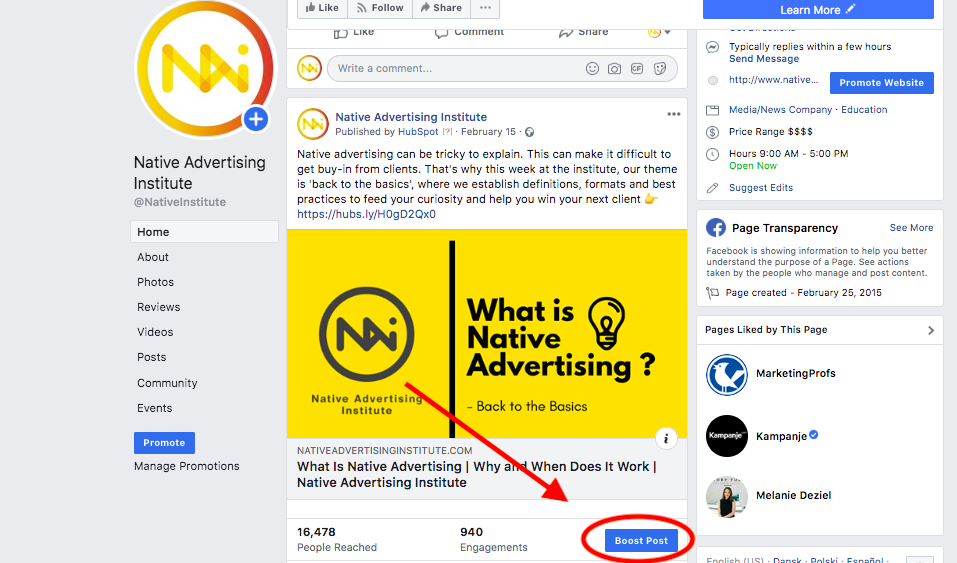
3. Specify your goal:
- Getting more website traffic
- Getting more engagements: reactions, comments and shares
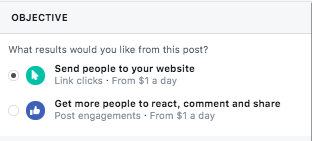
4. Select a CTA button between a number of preset options.
The option you choose will likely hold relevance to the kind of content you’re offering as well as the products or services you sell. Keep in mind, though, certain CTAs tend to work better than others.
5. Specify your target audience.
Choose between:
- People you choose through targeting: you can create an audience, whereby you specify an age range, gender, location and specific attributes, such as demographics, interests or behavior. You can also choose to specifically exclude certain audiences.
- People who like your page
- People who like your page and their friends
- People in your local area
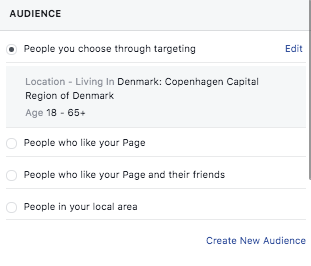
- You can also select an automatic audience: This is the one that Facebook decides upon, based on who it thinks would find your content relevant. This is the selection that Facebook recommends for the sake of getting the most bang for your budget.
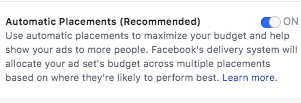
6. Set the duration of time you wish to sponsor your post for.
You can do this by selecting the number of days you want the Facebook post to be sponsored, or by selecting an end date for sponsorship.
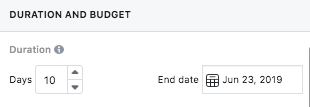
7. Set the budget for your sponsored Facebook post.
The amount of money you allocate will be split between the amount of time you specify for your post to be sponsored.
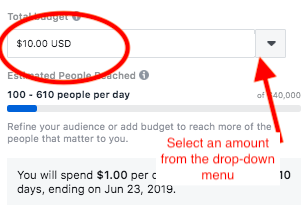
Once you’ve finished inputting your budget, be sure to turn on conversion tracking, which you can do with the slider icon at the bottom of this section. This will allow you to better understand the engagements you get from your sponsored efforts, in order to get a better indication of your return on ad spend.

8. Enter in your payment info.
Once you save your credit card info, you won’t need to complete this step again to sponsor a post.
9. Hit boost, and keep an eye on the results!
You’ll want to compare the results you’re seeing to the initial goals you set for the post. You can optimise your post copy, pictures, targeting, etc in line with what you learn. It good approach is to keep some sort of log with your learnings.

How much does Facebook sponsored posts cost?
Sponsoring a Facebook post can be rather affordable. In fact, you can start sponsoring a post on Facebook with as little as a $1 minimum. The cost of sponsoring a post on Facebook depends entirely on the size of the audience that you want to see your post. Facebook will provide you estimates of the number of people you can reach with the budget you specify.

A good approach is to first determine who exactly you want to reach, what you want those people to do and how much that action is worth to you.
What is the difference between Facebook sponsored posts vs Facebook ads?
Facebook sponsored posts and Facebook ads share many similarities. The primary difference lies in the tools used for their creation. To elaborate, Facebook ads are crafted through a dedicated platform known as "Ads Manager." Conversely, sponsored posts can be initiated directly from your business page.
In essence, while both serve the purpose of promoting content, the key disparity lies in the interface utilized for their development – Ads Manager for ads and the business page for sponsored posts.
READ MORE: 16 Innovative Content Formats You Need to Know
Facebook Ads
Facebook ads are created in Meta Ads Manager (now simply called the “Ads Manager”). So rather than simply creating them through your business profile, you would need to set them up through Ads Manager, which may require a bit of time to get to know.
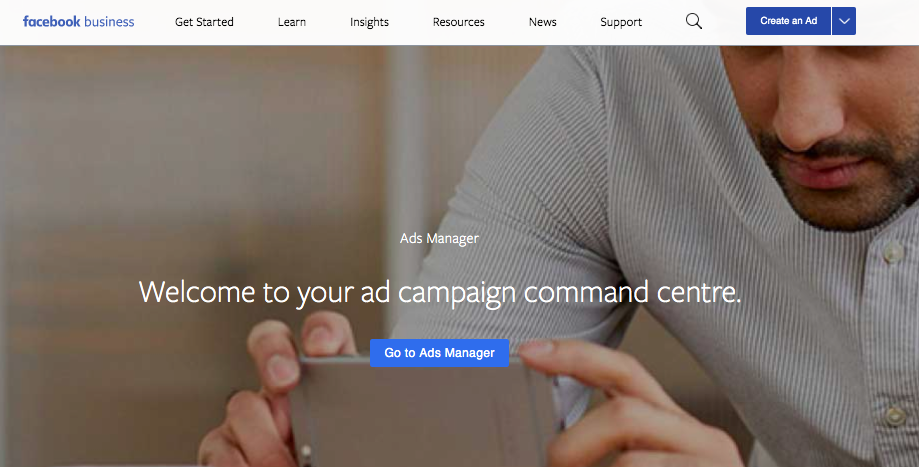
Once you do, though, Ads Manager will allow you more specification options when it comes to creating your audience and allocating your budget. Here are the main advantages:
Advantages of Facebook Ads
- No time limit: A Facebook Ad can run for as long as you like.
- More complex targeting and budgeting options
- With Facebook Ads, the following marketing objectives can be accomplished: awareness, traffic, engagement, leads, app promotion and sales. (Facebook used to have the objectives of brand awareness, reach, traffic, app instals, engagement, video views, lead generation, messages, conversions, catalogue sales, and store visits but these have been simplified to just six. If you used the previous objectives – Meta guides you here on how to select your new objective based on your previous objective.)
Disadvantages of Facebook ads
- You can’t create an ad straight from your business account, you will need to use Meta Ads Manager
- There is a slight learning curve you will need to get over before you can navigate Ads Manager and learn the best targeting and budgeting options. In this way, it’s a bit higher risk.
When should you use a Facebook sponsored post over a Facebook Ad?
- A Facebook Ad might be your best bet if your focus is a more long-term ad, built into a strategic campaign or content plan. Many companies, for example, appreciate the added control and greater customization that you get with Facebook Ads.
- A Facebook sponsored post is quick and easy to disseminate and great for one-off efforts. If your goal is increased awareness at an affordable price a Facebook sponsored post might be the best bet for you.
What is a Facebook Automated Ad?
Facebook Automated ads are those that Facebook helps you to create and disseminate on an ongoing basis with minimal maintenance needed.
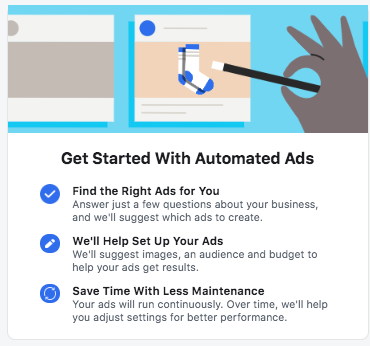
How do Facebook Automated Ads work?
Facebook will ask you a series of questions about your business and your goals. They’ll then give you suggestions about how to set up your ad, including inputs on images, budget and audience, based on these objectives.
Your ad will then run continuously and Facebook will instruct you as to how you can optimise it for the best results.
Success tips for Sponsored Facebook Posts and paid distribution in general on Facebook
Now that you’ve nailed down the basics, it may be time to consider the content you are posting to Facebook and how it fits into your overall strategy. We’ve got some resources that can definitely help you on this journey.
- First off, learn from industry best practices. While thinking out of the box and doing something different is the best way to get attention, you have to start somewhere. Your first step should probably be laying down the foundations and understanding how others were successful.
- Along the same lines, check out some great examples. We’ve put together some of our favorites here.
- Put it all into a larger strategy with set KPIs. Learn how here.
- Be aware, Facebook users are inundated with ads all the time. Your best bet is to be informative, not interruptive. Discover how you can approach Facebook in a non-disruptive way right here.
Feeling like an expert yet?
Now that you’ve mastered paid distribution on Facebook, perhaps you’re wondering about the other social media channels. Luckily, we’ve got you covered. Be sure to visit our article dedicated entirely to advertising on social media.





